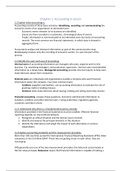Summary
SUMMARY Financial Accounting IFRS 3rd ed. ALL CHAPTERS Grade: 10!
- Course
- Institution
- Book
I went from a 2.0 (!) on my midterm (no summary) to a 10.0 (!!) on my endterm! This summary is responsible for it! ISBN: 8085 SUMMARY CONTAINING ALL CHAPTERS and some appendixes: CHAPTER 1 Accounting in Action The whole Chapter, including Appendix 1A LO 1.1 - LO 1.9 CHAPTER 2 The Rec...
[Show more]




